|
|||||||
Bruce Brown's 100 Voices... Iron Hail's Story of the Battle
In that long-ago time none of my people knew more than a thousand numbers. We believed no honest man needed to know more than that many. There was my own tribe, the Miniconjou. There were our cousins, the Hunkpapa, the Sans Arc, the Two Kettles, the Sihasapa [Blackfoot Sioux], the Brulé, and the Oglala -- all our Seven Council Fires. There were many of our eastern relatives, too -- the Yankton and the Santee. And our kinsmen from the north were there -- the Yanktonai and the Assiniboin. Our friends and allies the Cheyenne were there in force, and with them were smaller bands of Arapaho and Gros Ventre. It was a great village and we had great leaders. Hump, Fast Bull, and High Backbone led my tribe. Crazy Horse headed the Oglala. lnkpaduta [Scarlet Tip] led the Santee. Lame White Man and Ice Bear led the Cheyenne. But the greatest leader of all was the chief of the Hunkpapa -- Sitting Bull. As long as we were all camped together, we looked on him as head chief. We all rallied around him because he stood for our old way of life and the freedom we had always known. We were not there to make war, but, if need be, we were ready to fight for our sacred rights. Since the white man's government had promised our leaders that we could wander and hunt in our old territory as long as the grass should grow, we did not believe the white soldiers had any business in our hunting grounds. Vet they came to attack us anyway. I slept late the morning of the fight. The day before, I had been hunting buffalo and I had to ride far to find the herds because there were so many people in the valley. I came back with meat, but I was very tired. So when I got up, the camp women were already starting out to dig for wild turnips. Two of my uncles had left early for another buffalo hunt. Only my grandmother and a third uncle were in the tepee, and the sun was high overhead and hot. I walked to the river to take a cool swim, then got hungry and returned to the tepee at dinner time [noon]. "When you finish eating," my uncle said, "go to our horses. Something might happen today. I feel it in the air." I hurried to Muskrat Creek and joined my younger brother, who was herding the family horses. By the time I reached the herd, I heard shouting in the village. People were yelling that white soldiers were riding toward the camp.
I had no time to paint Zi Chischila properly for making war, just a minute or so to braid his tail and to daub a few white hail spots of paint on my own forehead for protection before I galloped out on the little buckskin to help defend the camp. I met four other Lakotas riding fast. Three were veteran fighters, armed with rifles; the other was young like me and carried a bow and arrows as I did. One of the veterans went down. I saw my chance to act bravely and filled the gap. We all turned when we heard shooting at the far side of the village nearest the Miniconjou camp circle and rode fast to meet this new danger. I could see swirls of dust and hear shooting on the hills and bluffs across the river. Hundreds of other warriors joined us as we splashed across the ford near our camp and raced up the hills to charge into the thickest of the fighting.
Then a Lakota named Spotted Rabbit rode unarmed among us, calling out a challenge to all the warriors to join him. He shouted, "Let's take their leader alive!" I had no thought of what we would do with this leader once we caught him; it was a daring feat that required more courage and much more skill than killing him. I dug my heels into my pony's flanks to urge him on faster to take part in the capture. A tall white man in buckskins kept shouting; at the soldiers and looked to be their leader. Following Spotted Rabbit, I charged toward this leader in buckskins. We were almost on top of him when Spotted Rabbit's pony was shot from under him. Zi Chischila shied to one side, and it was too late.
The soldier chief we had tried to capture lay on the ground with the reins of his horse's bridle tied to his wrist. It was a fine animal, a blaze-faced sorrel with four white stockings. A Santee named Walks-Under-the-Ground took that [Custer's] horse. Then he told everyone that the leader lying there dead was Long Hair; so that was the first I knew who we had been fighting. 1 thought it was a strange name for a soldier chief who had his hair cut short. [Note: Lazy White Bull said the Santee who got Custer's horse was named Sound the Ground as He Walks which is also sometimes translated as Noisy Walking.] Our attempt to save Long Hair's life had failed. But we all felt good about our victory over the soldiers and celebrated with a big scalp dance. But our triumph was hollow. A winter or so later more soldiers came to round us up on reservations. There were too many of them to fight now. We were split up into bands and no longer felt strong. At last we were ready for peace and believed we would have no more trouble. Excerpted from "Echoes of the Little Bighorn" by David Humphreys Miller, American Heritage, June 1971, p 28
Iron Hail was also known as Dewey Beard. His brother was Standing Bear. Iron Hail's account of the battle is the historic basis for Charging Hawk's claim to be the Man Who Killed Custer, but based on both the eye-witness accounts of the battle, and the subsequent developments on the battlefield that day, however, it appears that Custer was killed or seriously wounded at the very outset of the Custer fight, probably by White Cow Bull at the river before Custer's troops were fully engaged in the battle. Later, in the confusion of the final moments of the battle, it is impossible to say who may have been riding a sorrel horse. See Astonisher.com's Who Killed Custer -- Top Ten List for more info.
Miller frequenlty made pastel sketches of the Sioux survivors of the Battle of the Little Bighorn whom he interviewed. Some of Miller's portraits are exceptionally fine evocations of the historic personalities in their own right, such as his portraits of Lazy White Bull and Old Eagle and Black Elk late in life. Click here for information of David Humphreys Miller's sources among the Sioux, Cheyenne, Crow, Arikara and Apapaho. This material was excerpted from Custer's Fall by David Humphreys Miller, and appeared in American Heritage, June 1971. -- B.B. |
|||||||




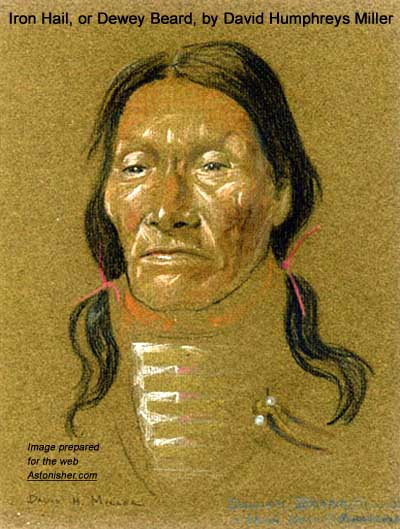
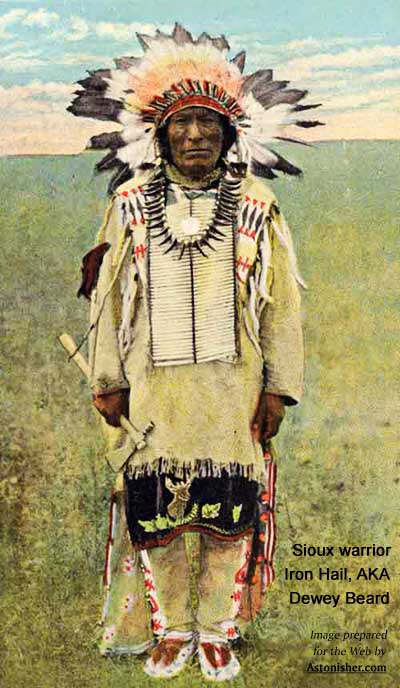
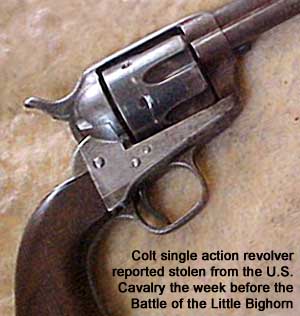
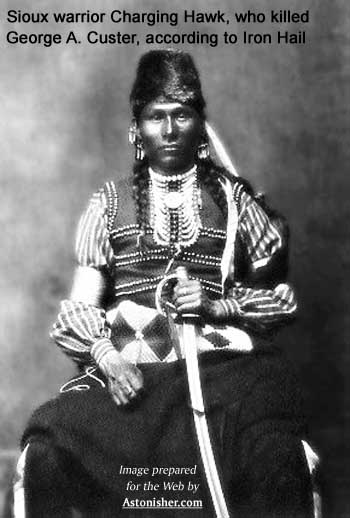 A Miniconjou named Charging Hawk rushed in and shot the leader at close range. In a little while all the soldiers were dead. The battle was over.
A Miniconjou named Charging Hawk rushed in and shot the leader at close range. In a little while all the soldiers were dead. The battle was over.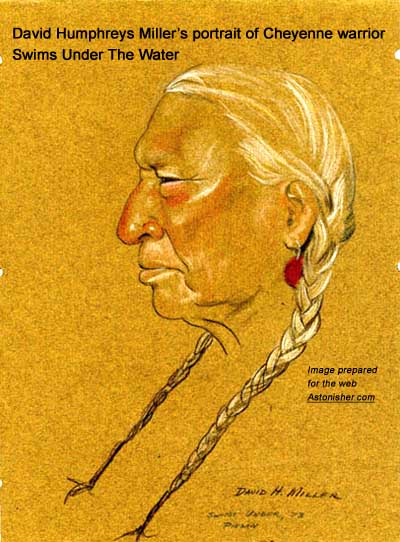 Although not born into the Teton Sioux, David Humphreys Miller was adopted late in life by both
Although not born into the Teton Sioux, David Humphreys Miller was adopted late in life by both 







